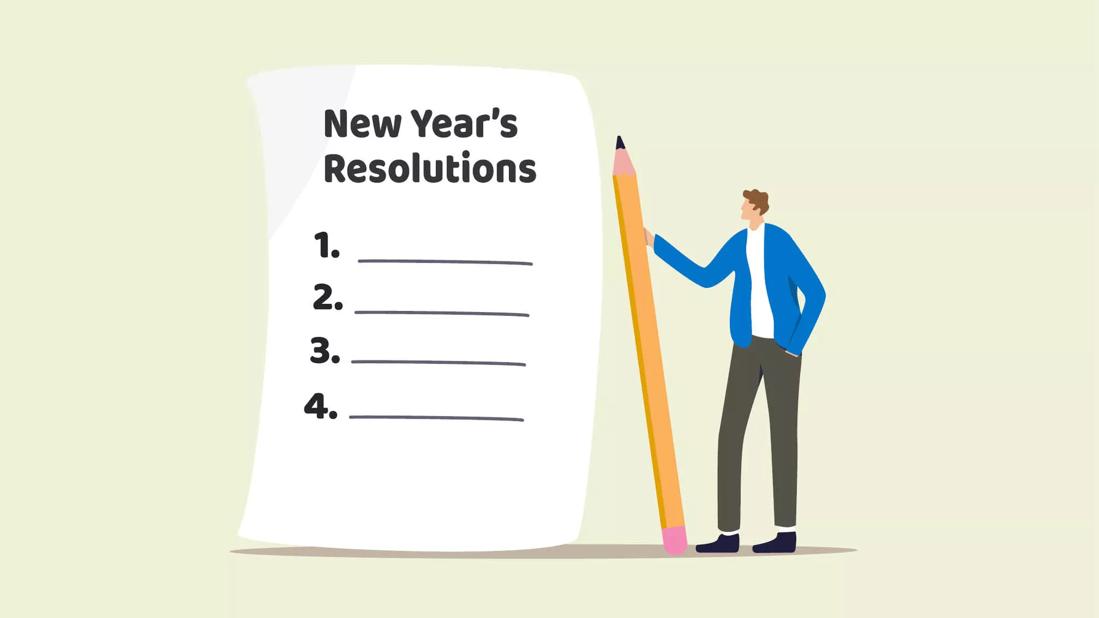Pick specific, measurable goals, but also be open to changing them if need be

A new year means a new you, right? As the calendar flips to a new date, you’ve made some resolutions to guide the way. Maybe it’s a pledge to eat healthier, exercise more or finally give up smoking for good.
Advertisement
Cleveland Clinic is a non-profit academic medical center. Advertising on our site helps support our mission. We do not endorse non-Cleveland Clinic products or services. Policy
Whatever your resolutions, odds are they’ll sound pretty familiar.
“People tend to set the same exact resolution year after year, which shows the gap between what we do and what we want,” says psychologist Susan Albers, PsyD. “But you can use psychology to fill in that gap and figure out how to change your habits to make your resolutions stick.”
But how can you make sure that this is the year your resolutions actually stick? Dr. Albers has some ideas to help you power through to a better you.
Change is a process — and processes take time. To make this the year you stick to your resolutions, follow these psychologist-recommended steps:
“It is not like a light switch,” clarifies Dr. Albers. “Many of the behaviors linked to resolutions involve activities or habits that you’ve had for years. Give yourself some time to adapt and make changes.”
Advertisement
Let’s delve deeper into each of her tips to help you select and achieve your goals for the new year.
Research indicates that it’s easier to start a behavior than to stop one — so instead of resolving to quit something, instead, resolve to begin doing something else. This is called an “approach goal” versus an “avoidance goal.”
“If you want to eat healthier, for example, your resolution could be to increase your fruit and vegetable intake rather than to avoid processed foods or cut out sugar,” Dr. Albers explains.
Here are some other examples of how to flip the script from stopping a behavior to starting one:
“Starting a healthy new behavior is going to put you on a better path to success,” Dr. Albers reiterates.
Choosing an unrealistic, unsustainable goal sets the stage for failure. Your resolution should reflect an activity or behavior you can do for the long-term.
“Fad dieting, for example, isn’t something that anyone can realistically keep up,” Dr. Albers says. “You’re better positioned for success if you focus on something like mindful eating, where you can focus on sustainable behaviors based on food choices and how and when you eat.”
The same is true for other types of resolutions, too:
Vague goals like “exercise more,” “drink less” and “cut back on sugar” are impossible to quantify. Instead, Dr. Albers says that it’s important to set small, actionable goals that are well-defined.
“Resolutions should be concrete,” she continues. “Instead of making a broad resolution to ‘exercise more,’ make a specific goal that you want to walk for 20 minutes a day. Give yourself an achievable target.”
Advertisement
Have you ever heard of “SMART goals”? This acronym helps you set and achieve goals that are:
When you’re coming up with your new year’s resolutions, set yourself up for success by choosing a SMART goal from the very start.
There can be a downside to setting very specific goals: When you don’t hit the mark, there’s nowhere to hide, and you may end up feeling discouraged or disappointed in yourself.
But have you ever heard the phrase “Progress over perfection”? You don’t have to get it 100% right every single day. Dr. Albers encourages you to give yourself some wiggle room and be willing to adjust your goals as needed.
If, for example, you resolved to exercise for 20 minutes every day, but today happens to be the busiest, most chaotic day ever, don’t beat yourself up about it. It’s OK to do 10 or 15 minutes instead!
“Be flexible and forgiving,” Dr. Albers says. “That can help you avoid feeling frustrated later.”
What’s likely to get in the way of your achieving your resolution? You probably already know what your potential pain points are, whether they’re physical obstacles (not having enough time) or emotional obstacles (like fear).
Advertisement
Sometimes, the solutions are practical ones: If you’re trying to order takeout less often or scale back on your social media use, delete the apps from your phone. If you never want to exercise by the end of the day, start doing morning workouts. You get the gist.
But if your obstacles are of the mental and emotional variety, you may have to put in extra effort to bring a healthy mindset to your new healthy habits:
“Identifying your obstacles right from the start can help you plan around them and be more successful,” says Dr. Albers.
Find a family member, friend or a professional (like a health coach) who can help keep you on track.
Why? Because one of the top predictors of success for keeping your resolution involves social support. In fact, one study found that 70% of people who sent weekly updates to an accountability partner were successful in reaching their goals, as compared to those who tried to go it alone.
You could also consider a group resolution. For example: A family that pledges to sit down together for dinner at least once a week.
Advertisement
“This gets everyone involved and engaged,” says Dr. Albers, “and then, you can all work together.”
It’s easy to get distracted with life and forget about your resolution. “Our minds are busy and active,” Dr. Albers notes. “It’s easy to set a goal and forget it quickly.”
To keep your resolution fresh and at the front of your mind, implement some little tricks:
“Keep data to help you track your progress, but it can also help you on days where it’s not going well,” says Dr. Albers. “Looking back over time to see how you’re doing can help keep you motivated.”
She suggests keeping a journal or tracking your progress on an app. If your goal is focused on exercise, for instance, there are numerous apps to log your activity. Ditto for food-based resolutions.
But you don’t necessarily need a solution that’s specific to your resolution. Try a habit-tracking app or journal to make it easy to keep track of what you’ve been up to.
There’s something to be said for setting specific goals — but there are other ways to focus on self-improvement, too.
If you’re not in the mood to pick a New Year’s resolution in the traditional sense, Dr. Albers says that you could try to set an intention instead. This might include, for example, “I want to be more positive” or “I’m going to be more adventurous.”
Here’s a realistic expectation regarding resolutions: You may not follow through with it. In fact, one study found that nearly 1 out of 4 resolution-makers didn’t maintain their new behavior past a week. One month into the new year, almost half of the participants had already given up on their goals.
In other words, it happens. But you can get back on track any time, not just at the start of the year.
“Real and lasting change happens when a person feels ready, not by picking an arbitrary date on a calendar,” Dr. Albers says.
If you encounter struggles, don’t give up. Instead, focus on getting back on track and not beating yourself up over a misstep.
“Be kind and compassionate toward yourself,” she encourages. “Change takes time. Just keep going and be persistent. Come back to your goal and give yourself an opportunity to make changes in small and achievable ways.”
Here’s to a new you in the new year. Good luck!
Learn more about our editorial process.
Advertisement

This social media productivity hack involves carving out time every morning for self-care

Face-touching is a common habit, but one that can be overcome, like by learning to recognize when you’re doing it and keeping your hands distracted

This old trick for building habits can work, but you still need motivation, repetition and discipline to get results

It may feel impossible, but planning, motivation and goal-setting can make leaving old habits behind doable

Little changes can yield big results

Couples counseling and communication are key to addressing built-up issues and changing needs

Major life events and trying times can trigger reactive depression symptoms, like prolonged sadness, irritability and hopelessness

Weightlifting and other types of resistance training bring many health benefits

If you’re feeling short of breath, sleep can be tough — propping yourself up or sleeping on your side may help

If you fear the unknown or find yourself needing reassurance often, you may identify with this attachment style

If you’re looking to boost your gut health, it’s better to get fiber from whole foods